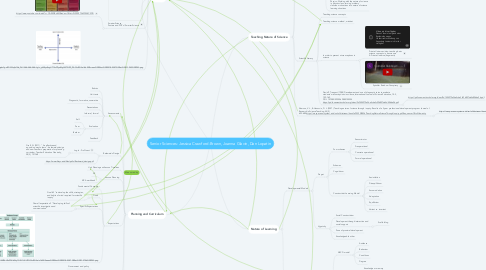
1. Inquiry
1.1. Levels
1.1.1. Confirmation
1.1.2. Structured
1.1.3. Guided
1.1.4. Open
1.1.5. https://1.bp.blogspot.com/-CjZdsGdAT5k/WqAt1OmqLfI/AAAAAAAAALk/lteehI2NtUA86-IbcOWf_UOG4Aokvp8jACLcBGAs/s1600/Screen%2BShot%2B2018-03-07%2Bat%2B1.19.24%2BPM.png
1.2. Smarter Science Posters and PDF's | Smarter Science
1.2.1. https://www.youtube.com/watch?v=CSrEK2iBdkM&index=1&list=PL5E0E7362F0A3C2DD
1.3. https://3.bp.blogspot.com/-urg6sYgmZDI/WqAt1A6_PhI/AAAAAAAAALg/v_yhA2yz8ngUT14vDTywWgf43TNI19_ZACLcBGAs/s1600/Screen%2BShot%2B2018-03-07%2Bat%2B1.19.45%2BPM.png
2. Planning and Curriculum
2.1. Assessments
2.1.1. Rubrics
2.1.2. Unit tests
2.1.3. Diagnostic, formative, summative
2.1.4. Presentations
2.1.5. Informal, formal
2.1.6. Evaluation
2.1.6.1. Self
2.1.6.2. Peer
2.1.6.3. Teacher
2.1.7. Feedback
2.2. Backwards Design
2.2.1. Log In - ProQuest
2.2.1.1. Graff, N. (2011). " An effective and agonizing way to learn": backwards design and new teachers' preparation for planning curriculum. Teacher Education Quarterly, 38(3), 151-168.
2.2.2. https://www.fitnyc.edu/files/pdfs/Backward_design.pdf
2.3. Unit Planning and Lesson Timelines
2.4. Lesson Planning
2.4.1. 5E
2.4.2. KICA workbook
2.5. Expectations
2.5.1. Fundamental Concepts
2.5.2. Goals
2.5.2.1. Goal #2 "to develop the skills, strategies, and habits of mind required for scientific inquiry"
2.5.3. Specific Expectations
2.5.3.1. Overall expectation 2 "Developing skills of scientific investigation and communication"
2.5.4. https://3.bp.blogspot.com/-tj6_33GCW3c/WqAvVTId_CI/AAAAAAAAAL0/NtM2gIfH4MYbLRs9DU-h5ky1GiQ1UUUPQCLcBGAs/s1600/Screen%2BShot%2B2018-03-07%2Bat%2B1.27.06%2BPM.png
2.6. Influences of Curriculum
2.6.1. Governmnet and policy
2.6.2. Public
2.6.3. School administration
2.7. Incorporation of
2.7.1. Indigenous knowledge systems
2.7.1.1. Indigenous knowledge in Canadian science curricula: cases from Western Canada
2.7.1.1.1. Kim, M. (2017). Indigenous knowledge in Canadian science curricula: cases from Western Canada. Cultural Studies of Science Education, 12(3), 605-613.
2.7.1.2. Login Required - OWL
2.7.2. Technology
2.7.3. Environment and sustainability
3. Teaching Nature of Science
3.1. Activities
3.1.1. Survey on Nature of science knowledge
3.1.2. Mystery Tube activity
3.2. Nature of science articles
3.2.1. Chemistry: The Nature of Science and the Teaching of High-School Chemistry
3.2.1.1. Theory vs law
3.2.1.2. Addressing research bias
3.2.2. Biology: Farber Paul History Teaching Evolution Nature
3.2.2.1. History of evolution
3.2.2.2. How evolution has been taught in the past and today
3.2.3. Physics: Working with the nature of science in physics class: turning 'ordinary' classroom situations into nature of science learning situations
3.3. Scientific literacy
3.3.1. Teaching science concepts
3.3.2. Teaching science method, mindset
3.3.3. In order to prevent misconceptions in science
3.3.3.1. Private Universe video: teaching basic science concepts in classrooms A Private Universe (fragments)
3.3.3.2. Sprinkler Rainbow Conspiracy
3.3.4. David F. Treagust (1988) Development and use of diagnostic tests to evaluate students’ misconceptions in science, International Journal of Science Education, 10:2, 159-169, DOI: 10.1080/0950069880100204 https://pdfs.semanticscholar.org/daec/9d1404979e3ba4cba3c596857de4d4066e56.pdf
3.3.4.1. https://pdfs.semanticscholar.org/daec/9d1404979e3ba4cba3c596857de4d4066e56.pdf
3.4. Akerson, V. L., & Hanuscin, D. L. (2007). Teaching nature of science through inquiry: Results of a 3‐year professional development program. Journal of Research in Science Teaching, 44(5), 653-680.https://mospace.umsystem.edu/xmlui/bitstream/handle/10355/8826/TeachingNatureScienceThroughInquiry.pdf?sequence=1&isAllowed=y
3.4.1. https://mospace.umsystem.edu/xmlui/bitstream/handle/10355/8826/TeachingNatureScienceThroughInquiry.pdf?sequence=1&isAllowed=y
4. Nature of Learning
4.1. Developmental Models
4.1.1. Piaget
4.1.1.1. Four schemas
4.1.1.1.1. Sensorimotor
4.1.1.1.2. Preoperational
4.1.1.1.3. Concrete operational
4.1.1.1.4. Formal operational
4.1.1.2. Schemas
4.1.1.3. Cognitivism
4.1.1.4. Constructivist Learning Model
4.1.1.4.1. Assimilation
4.1.1.4.2. Disequilibrium
4.1.1.4.3. Accomodation
4.1.1.4.4. Adaptation
4.1.1.4.5. Equilibrium
4.1.1.4.6. Variant vs. invariant
4.1.2. Vygotsky
4.1.2.1. Social Constructivism
4.1.2.2. Development through interaction and social support
4.1.2.2.1. Scaffolding
4.1.2.3. Zone of proximal development
4.1.2.4. Knowledgeable other
4.2. Teaching Model
4.2.1. Bloom's Taxonomy
4.2.1.1. ABCD model
4.2.1.1.1. Audience
4.2.1.1.2. Behaviour
4.2.1.1.3. Conditions
4.2.1.1.4. Degree
4.2.1.2. Cognitive Domain
4.2.1.2.1. Knowledge or memory
4.2.1.2.2. Comprehension
4.2.1.2.3. Application
4.2.1.2.4. Analysis and interpretation
4.2.1.2.5. Synthesis
4.2.1.2.6. Evaluation
4.2.1.2.7. Bloom’s Taxonomy

